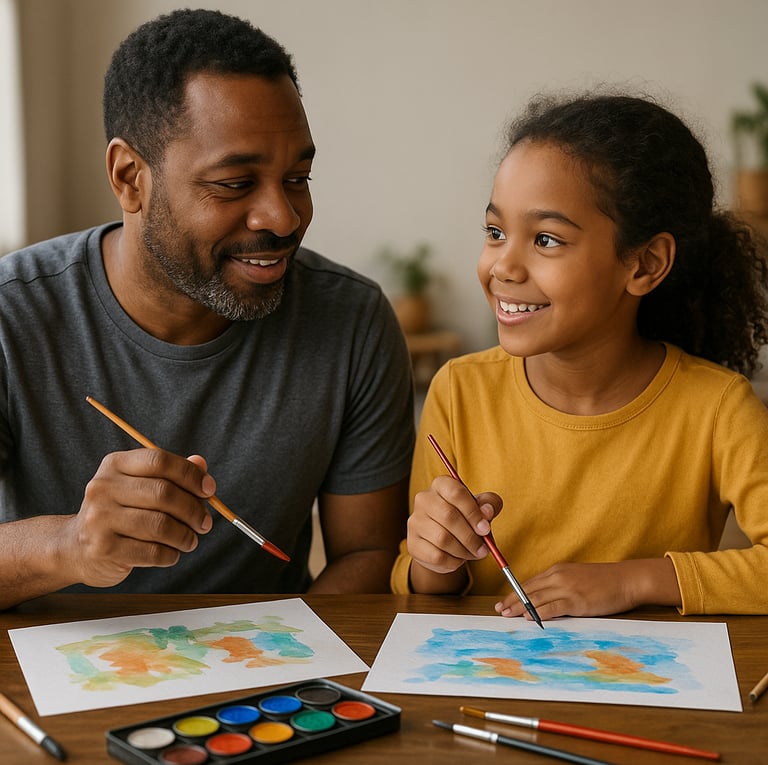Creating Art Together: Strengthening Bonds Through Shared Creativity
Discover how creating art together can strengthen parent child bonding, foster quality time, and inspire meaningful conversations. Includes parenting tips, mindful parenting strategies, and dialogue prompts.
BONDING ACTIVITIES
Collin Kelly
8/3/20254 min read


In our busy lives, finding simple yet meaningful ways to bond with our children can feel like a challenge. With the rush of work, school, and daily responsibilities, it’s easy to let quality time slip by. But there’s a powerful, joyful activity that invites both connection and creativity: creating art together.
Whether you’re painting, drawing, sculpting with clay, or experimenting with collages, making art side by side opens the door to conversation, laughter, and lasting memories. Let’s dive into practical tips, mindful parenting strategies, and inspiring ideas to turn art time into a cherished family tradition.
Why This Activity Matters for Parent‑Child Bonding
When you sit down to create art with your child, you’re giving them more than brushes and colors—you’re giving them your attention, encouragement, and presence. Shared art sessions are a unique type of family activity because they blend freedom and focus.
Imagine this:
You spread out paper and paints on the kitchen table. Your child dips a brush into blue, carefully making swirls, while you sketch beside them. A comfortable silence settles in, broken only when they giggle and say, “Look! It’s a dragon!” Suddenly you’re talking about dragons, favorite stories, and dreams for the future.
Creating art together is a natural way to practice mindful parenting. There’s no screen in the way, no agenda to rush through. Instead, you’re slowing down, noticing details, and celebrating the process rather than the outcome. That’s a powerful lesson for kids—and a beautiful way to build trust and confidence.
Parenting tip: Praise effort, not just results. Say, “I love how you used those colors,” or “You worked so carefully on that shape.” This reinforces self‑esteem and encourages exploration.
How to Prepare and Minimize Distractions
The more intentional you are about setting up art time, the more relaxed and fun it will feel. Here’s how to make it easy and enjoyable:
Create a dedicated art space. It can be a corner of the dining table or a small desk. Lay down newspaper or a plastic cloth to catch messes.
Keep supplies ready. Have crayons, markers, paints, glue, and paper in a bin so you’re not scrambling when inspiration strikes.
Limit tech distractions. Put phones on silent and turn off the TV. Let your child see that your focus is on them and the art you’re making together.
Wear comfy clothes. Art can be messy—embrace it! Put on old t‑shirts or aprons so you can both relax and enjoy the process.
Set a routine. Maybe Saturday mornings become your family’s art time. Children thrive on consistency and look forward to shared activities.
Mindful parenting tip: When you minimize distractions, you model what it means to be present. That focused attention is a gift your child will feel deeply.
Step‑by‑Step Ideas to Make the Most of It
Here’s a simple guide to turning an ordinary art session into an extraordinary bonding experience:
Choose a theme. Maybe it’s “Under the Sea,” “Family Portraits,” or “Our Dream Vacation.” Themes spark imagination and conversation.
Set out materials ahead of time. Having everything ready invites your child in and keeps the mood calm.
Work side by side. Instead of hovering or directing, sit next to your child and create your own piece. This builds confidence and encourages independence.
Share as you go. “I’m drawing a tree. What are you making?” invites dialogue without pressure.
Celebrate the process. Display finished artwork on the fridge or create a rotating art wall. Let your child know their effort matters.
Wrap up with reflection. “What part of making this art did you enjoy the most?” helps your child process and appreciate the time together.
These steps turn simple family activities into treasured memories and a strong foundation for parent‑child bonding.
Example Dialogues to Encourage Connection
Art time is the perfect moment to sprinkle in meaningful conversations. Here are some examples:
Example 1
Parent: “I love spending this time with you. What part do you enjoy the most?”
Child: “I like when we try new things together!”
Example 2
Parent: “Your picture is so creative! How did you come up with that idea?”
Child: “I saw something like it in a book at school!”
Example 3
Parent: “If you could paint anywhere in the world, where would it be?”
Child: “On a big wall outside so everyone could see!”
These little conversations open doors to your child’s inner world and make them feel truly seen.
Prompts to Deepen the Experience
Want to encourage even more connection? Use prompts like these while you create together:
“What’s your favorite memory from our art time so far?”
“If we could try a new kind of art next week, what would you pick?”
“How can we make our art table even more fun?”
“What colors or shapes make you feel happy?”
Parenting tip: Keep prompts light and playful—this is about connection, not perfection.
Real‑Life Story to Inspire You
One mom shared this with me:
“I used to think I wasn’t ‘artistic,’ but my daughter loves drawing. I started sitting with her while she painted, and soon we were making collages together every Sunday. We talk about everything while we create—her friends, her dreams, even little worries. Our art time has become our special thing, and I wouldn’t trade it for anything.”
Art doesn’t have to be perfect—it just has to be shared.
Final Thoughts and Encouragement
Creating art together is more than a craft project. It’s a moment to slow down, laugh, and see the world through your child’s eyes. By setting aside distractions, making space for creativity, and being present, you’re practicing mindful parenting and building a well of shared memories.
Even 20 minutes with crayons or paints can leave a lasting impact. What your child will remember isn’t how the art turned out—it’s how loved and valued they felt while making it with you.
So gather some supplies, clear a little table space, and start creating. Your child’s masterpiece might just be the bond you build along the way.
